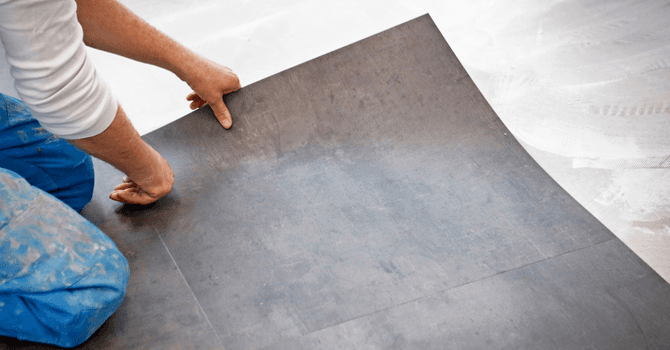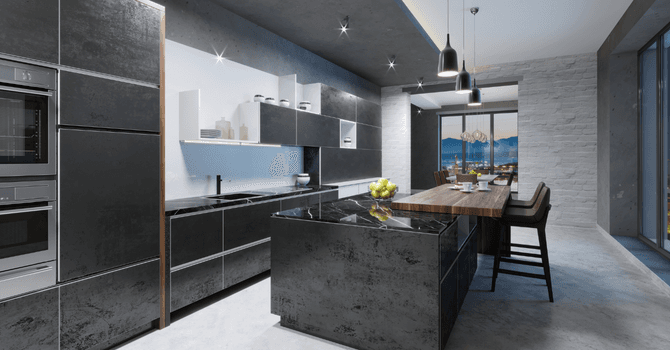
Made with plastic, vinyl first made its way onto the market in the shape of records (the infamous LP) or even as shiny items of clothing. During the 80s, this material became a popular, cushiony flooring option, vinyl sheets, or loose lay vinyl, which was also known as “cushion flooring.”
Back then, vinyl flooring was considered cheap, and consequently, people mostly used it to cut back on their interior design costs.
Nowadays, its quality has improved, and vinyl flooring is available in a variety of models to suit all preferences. Prior to vinyl, there was linoleum, and when it comes to this material, it was disused for a couple of decades, before making a modern comeback, most notably in the shape of Marmoleum.
Pros and Cons of Vinyl Flooring

Photo: Canva
Vinyl flooring rolls, also known as “vinyl sheet flooring,” is malleable, it adapts to an uneven and imperfect subfloor, and can be laid without any obvious joints. It’s the perfect material to be laid directly atop a variety of substrates, such as concrete, plywood, and existing vinyl flooring. It’s durable and withstands varying temperatures and humidity levels.
As such, it’s an excellent option in a kitchen, bathroom, or family room! It’s sold in tile, roll, or laminate vinyl form.
Similarly to vinyl tiles, vinyl sheets are sold in an array of thicknesses and various patterns that can mimic wood, ceramic, natural stone, cork, etc.
Vinyl flooring is water-resistant, which makes it easy to maintain, especially in moisture-prone areas like the bathroom or the basement.
In a nutshell, here are the pros and cons of vinyl flooring:
Pros:
Can be laid atop a wide variety of subfloors.
Good lifespan.
Can adapt to varying temperatures and humidity levels.
It’s waterproof, which means it can be installed in the kitchen or bathroom.
It’s affordable.
It’s easy to maintain.
Cons:
It can be hard to remove when wanting to change the flooring.
One must be careful not to damage the surface when moving furniture.
Sun exposure can cause the material to fade.
Pros and Cons of Linoleum or Marmoleum Flooring

Source: Canva
Linoleum flooring was, for a really long time, responsible for embellishing the floors in convents, rectories, and hospitals. It doesn’t contain any chemical products, since the ground limestone found in its making is entirely plant-based.
Flaxseed oil is then added to this substance, along with pine resin, cork powder, wood flour, jute, as well as heavy metal pigments for colouring. This combination is compressed against jute matting and dried with the help of oxygen. In short, linoleum is an eco-friendly choice since it’s biodegradable.
After being left idle for decades, Marmoleum reflects the epic revival of linoleum. This type of flooring is made with natural materials like wood, plant-based resins, flaxseed oil, and jute.
It doesn’t emit volatile organic compounds (VOCs), and solvent-free adhesives can be used for installation purposes. Offered in a wide variety of colours, Marmoleum is available in roll and tile form, which is much easier to install.
Marmoleum is an advantageous flooring material because it’s eco-friendly, durable, easy to maintain, flexible, fireproof, and hygienic, on top of having antistatic and antimicrobial agents.
Previously, it had a reputation for being somewhat difficult to install and likely to cause problems joint-wise, since the latter had to be sealed to prevent liquid and bacteria infiltration.
However, since a new installation technique was developed, known as Net fit, it’s no longer the case. This technique, when done according to the golden rules and with Forbo adhesive, makes the flooring very water-resistant and reduces installation costs and duration.
Nonetheless, hiring a professional to carry out the task is essential since it’s still much more difficult to install compared to other materials like vinyl.
Also, note that due to its malleability, Marmoleum flooring (as well as linoleum) must be laid atop a perfect surface. Otherwise, the slightest imperfection in the floor will be noticeable. Lastly, a small environmental caveat: Marmoleum originates from Europe, thus the pollutants issued from transportation are non-negotiable.
To sum it up, the pros and cons of linoleum or Marmoleum flooring are as follows:
Pros:
Compared to vinyl, they’re more eco-friendly and biodegradable.
Daily maintenance is easy (although less so than vinyl).
They’re fireproof (fuel-resistant).
Using the new Net fit installation technique, they’re also easy to install.
They’re resistant (to water as well).
Linoleum flooring is available in a wide variety of colours and patterns.
Cons:
It’s important that they be installed on smooth, even surfaces only. Otherwise, subfloor imperfections will show through.
Marmoleum is made in Europe, thus one has to consider the ecological footprint in terms of transportation.
You’ll have to hire an expert to carry out the linoleum flooring installation since it’s a complex procedure.
Like vinyl, linoleum can become yellow or fade when exposed to sunlight.
Linoleum flooring can be slippery when wet.
What’s the average cost of vinyl, Marmoleum, and linoleum flooring?

Source : canva
VINYL
According to RenoQuotes.com, vinyl flooring tiles cost $4.50 to $14.50 per square foot, and at least $6 per square foot for vinyl sheet flooring.
LINOLEUM
According to La Presse (French only), the cost of installing linoleum is between $2.50 and $6 per square foot.
MARMOLEUM
According to CAA Québec, rolls cost between $2.50 and $6 per square foot, and for tiles, prices start at $6. Tile installation costs are between $0.60 and $1.50 per square foot and $17 per square yard for a roll, sealant included.
In accordance with EcoHome (French only), there can be a significant price gap from one model to another, but it’s typically priced around $4.50 to $7.50 per square foot. It’s a relatively expensive product, but it’s still competitively priced with regard to other options, like hardwood or cork.
Where can you buy vinyl or linoleum flooring?

Source : canva
Vinyl or linoleum flooring materials are easy to find on the market. There’s a great variety available in department/hardware stores and in flooring supply stores.
Note that, in all retailers, you can often find vinyl flooring on sale. Keep an eye out for your weekly flyers from flooring retailers and manufacturers.
Why choose linoleum for commercial or institutional spaces?
Gymnasiums, recreational centres, dance studios, classrooms, and hallways: These very frequented and heavily trafficked areas often have vinyl or linoleum flooring. This type of flooring is actually extremely resistant to scratches. Thereby, they’re perfectly suited for commercial spaces with the sole purpose of welcoming an enormous amount of guests.
A Few Examples of Vinyl Floors
To give you a better idea of what your vinyl floors could look like, we’ve found a few worthy examples while perusing Pinterest. Here are different vinyl flooring options that are perfectly fitted to the rest of the room:

Source: Canva
A fashionable vinyl-tiled kitchen floor adorned with a retro pattern that’s still super trendy.

Source: Canva
A really pretty floor that mimics wood, thereby creating a cozy vibe.

Source:Canva
The flooring is used as a way to outline the home’s entryway while also serving as a waterproof and easy-to-clean surface.
A Few Examples of Linoleum and Marmoleum Floors
If you really like the fact that linoleum is eco-friendly, yet you’d still like to have a better idea in regard to the product to help you make up your mind, here are a few examples of linoleum floors:

Source: Canva
A linoleum floor that’s perfectly suited for commercial spaces.

Source: Canva
A floor with a unique pattern, reminiscent of the very popular gingham clothing fabric.

Source: Canva
A solid-coloured floor with a matte finish, ideal for a kitchen.
To have an idea as to the average cost of various renovation projects, check out our 2023 Home Renovation Price Guide.
Author: René-Maxime Parent
Source cover photo: Paul - Flickr
Get 3 quotes for your floor renovation project
RenoQuotes.com can help you get quotes for your flooring project. By submitting your project, we’ll put you in contact with top-rated contractors. Fill in the form on the homepage (it only takes a few minutes), and you'll receive quotes from trusted professionals.
Dial 1-844 828-1588 to speak with one of our customer service representatives.
Looking for something else?
Related articles
The latest industry news, interviews, technologies, and resources.

Editorial Team
•11 Aug 2025
Whether for the kitchen, the bathroom, or other rooms in the house, ceramic is a material known for its various colours, shapes, and patterns. Typical properties of ceramic material include wear resistance, heat resistance, high hardness, good electrical insulation, and a certain lightness.

Editorial Team
•07 Nov 2023
Are you looking for a tile model that will add a touch of originality to your decor? Whether you're renovating your kitchen, bathroom or another room of your home, tile replacement will likely be an integral part of your home improvement project.

Editorial Team
•06 Feb 2025
When designing a luxury kitchen, nothing is done haphazardly. From material to colours, with layout and finishes in between, everything is thoughtfully crafted. From the most minute detail, everything counts when building a dream kitchen. Are you looking for ideas for designing your custom-built, high-end kitchen? Keep reading for key insight!

Christine Simard
•07 Nov 2023
While some renovations require professional assistance, others can easily be done on your own. Of these jobs, applying grout is probably one of the easiest to perform, especially if you like getting your hands dirty!

Editorial Team
•07 Nov 2023
Our homes are complex systems that are multifunctional and multi-faceted with a lot of various parts. Thus, it is important for our homes to run smoothly and efficiently like well-oiled machines. All machines need energy to operate, and as most homeowners know, our homes consume a large amount of energy annually.